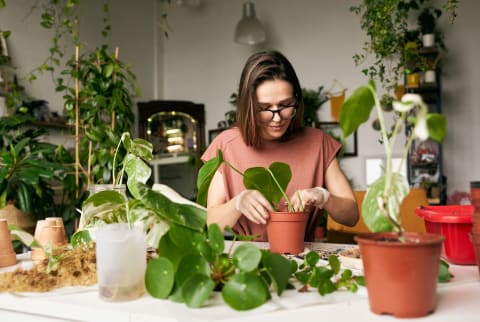Advertisement
How To Prevent Mold From Growing On Your Beloved Houseplants


For many plant enthusiasts, indoor vegetation is a must. Not only do houseplants add pops of color and personality to a space, but they can also help improve our mental health at home. Unfortunately, mold can turn these leafy friends into a health hazard.
That's not to say you should kick your fern or fiddle-leaf fig out of the house, though! Just follow these tips to keep them mold-free.
Why does mold grow on houseplants?
Most species of mold spores need two main components to transition into living colonies: a food source and a water source.
The organic material in plants' potting soil offers plenty of edible options for mold spores. Dead debris, such as leaves, can also attract mold. And finally, organic particles floating around in your indoor air, such as skin cells, can also supply mold with life-giving energy.
As for moisture, plants need water to grow just as much as mold does. This can create the perfect opportunity for a spore to start growing right alongside the plant, either in its soil or on the plant itself.
When mold grows on a houseplant, it releases microscopic spores into the surrounding area. Some species also create and release microscopic toxins called mycotoxins, further increasing the number of particles in the area. As long as the mold colony is thriving, it will continue to emit these particles.
Over time, this will decrease indoor air quality as these particles are small enough to become airborne and be inhaled, ingested, and absorbed into the body. Exposure to this poor indoor air quality can trigger a long list of potential symptoms that vary based on factors such as species of mold, the presence of mycotoxins, and the health of an individual's immune system.
How to prevent mold on houseplants
An ounce of prevention is worth a pound of cure, especially when it comes to indoor microbial growth. Here are eight things you can do to safeguard your houseplants from mold:
- Start with a clean slate: Give your plants the best chance of thriving by using sterile soil for seeds or when repotting. By doing so, you eliminate any lurking mold that may be present in old soil. Consider using commercial potting soil, which is often rich in nutrients and sterilized by the manufacturer.
- Don't drown your plants: Mold loves moisture, so it's crucial to avoid overwatering. While each plant has its own unique moisture needs, a handy rule of thumb is to let the top layer of soil dry completely before watering again. To check if your houseplant is thirsty, simply touch it with your finger or use a soil moisture meter.
- Clear away the extras: Get in the habit of composting dead leaves, dust, and other organic debris that could become an unintended food source for mold spores and trap moisture. Regularly removing these elements will help your plants stay in their best shape.
- Embrace the dehumidifier: Plants often create a humid environment, which can be a breeding ground for mold. To maintain indoor humidity levels between 35 and 50%—ideal for preventing mold growth—consider investing in a dehumidifier. These handy devices extract excess moisture from the air, helping to keep it fresh and mold-free.
- Let the air flow: Good air circulation is key for combating moisture buildup at home. As mold can develop within 24 to 48 hours, you'll want to ensure proper air movement to prevent any contamination. Placing a fan in the same room as your plants and running it on a low setting will promote a dry environment.
- Add drainage: Avoid water buildup by placing your plant in a pot that is the right size and has a hole in the bottom. This will ensure your plants have proper drainage to allow any excess water to escape.
- Shed some light: Sunlight or artificial light not only helps your plants grow but also keeps things dry and discourages mold. Providing adequate light will not only benefit your plants' overall health but also minimize the risk of mold growth.
- Use natural antifungal remedies: Consider using natural antifungal agents like cinnamon in your plant's soil. Cinnamon acts as a natural fungicide1 and can help prevent mold growth. Sprinkling a bit of cinnamon in the soil can provide an extra layer of protection against mold infestation.
The takeaway
Don't take this information as a sign you shouldn't have indoor plants! By following these mindful practices, you'll create an environment that not only nurtures your plants' well-being but also keeps mold at bay, ensuring a healthy and thriving indoor oasis.
Watch Next
Enjoy some of our favorite clips from classes
Enjoy some of our favorite clips from classes
What Is Meditation?
Mindfulness/Spirituality | Light Watkins
Box Breathing
Mindfulness/Spirituality | Gwen Dittmar
What Breathwork Can Address
Mindfulness/Spirituality | Gwen Dittmar
The 8 Limbs of Yoga - What is Asana?
Yoga | Caley Alyssa
Two Standing Postures to Open Up Tight Hips
Yoga | Caley Alyssa
How Plants Can Optimize Athletic Performance
Nutrition | Rich Roll
What to Eat Before a Workout
Nutrition | Rich Roll
How Ayurveda Helps Us Navigate Modern Life
Nutrition | Sahara Rose
Messages About Love & Relationships
Love & Relationships | Esther Perel
Love Languages
Love & Relationships | Esther Perel

















